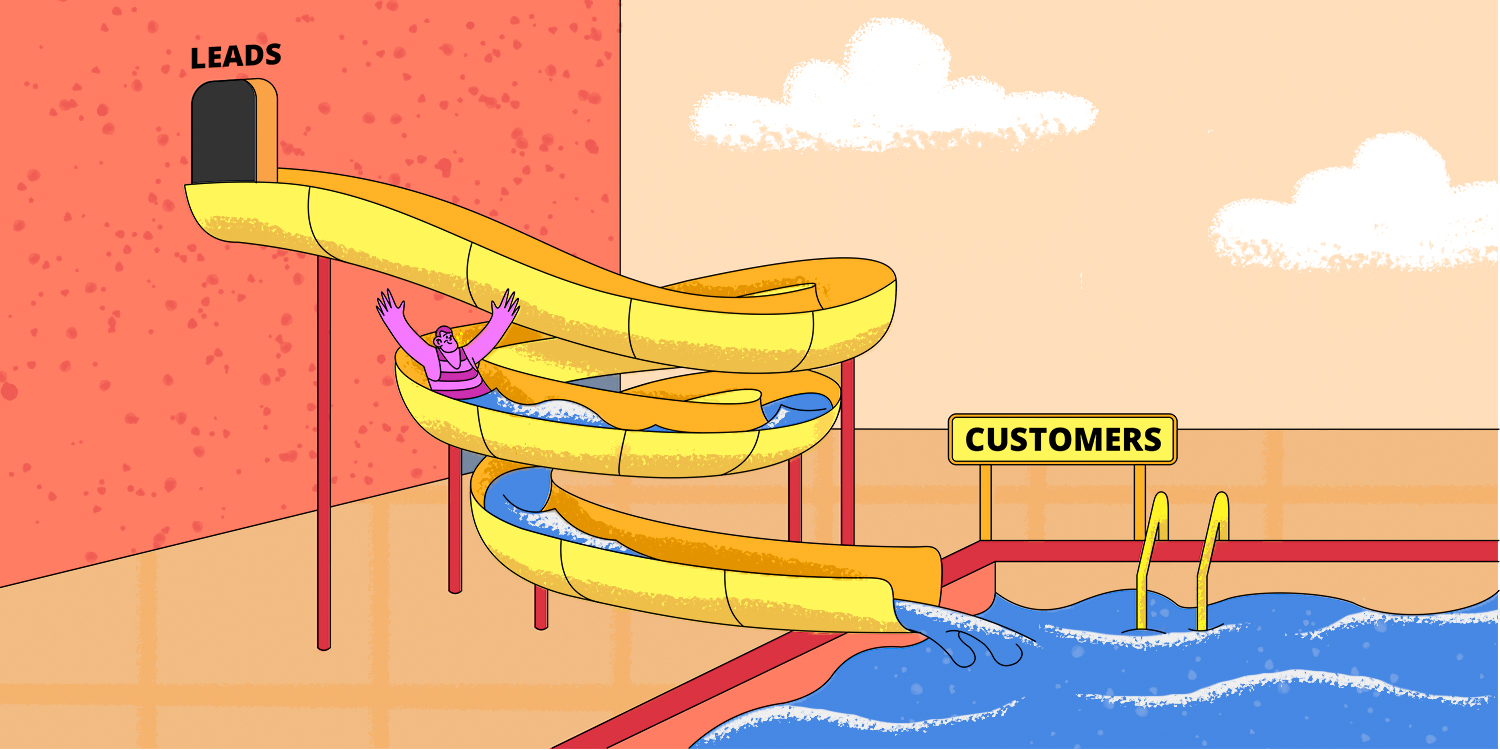It hurts to see how businesses with strong ambitions and all resources at their disposal get lost in the middle of the stairway to success because of one reason: their sales and marketing teams aren’t in the bunch.
And it hurts even more to realize this misalignment can cost your company over 1 trillion dollars per year and countless days wasted on unproductive prospecting.
Let’s discuss why any second of your time counts when it comes to aligning your sales and marketing processes and how to make both teams go together to bring you more revenue.
Outline:
What is sales and marketing alignment?
You’ve probably heard something about Smarketing, haven’t you?
This term is a combination of two words, ‘sales’ and ‘marketing,’ and it refers to the sales and marketing alignment strategy for achieving business growth.
Smarketing consists in building a shared system of goals that enables both teams to perform as a unified organization.

Sales and marketing departments often used to operate separately from each other. Marketing teams were responsible for the top of the funnel, where the goal was to attract new leads. Meanwhile, sales teams owned the bottom of the funnel, where leads were handed over from a marketing team to close deals.
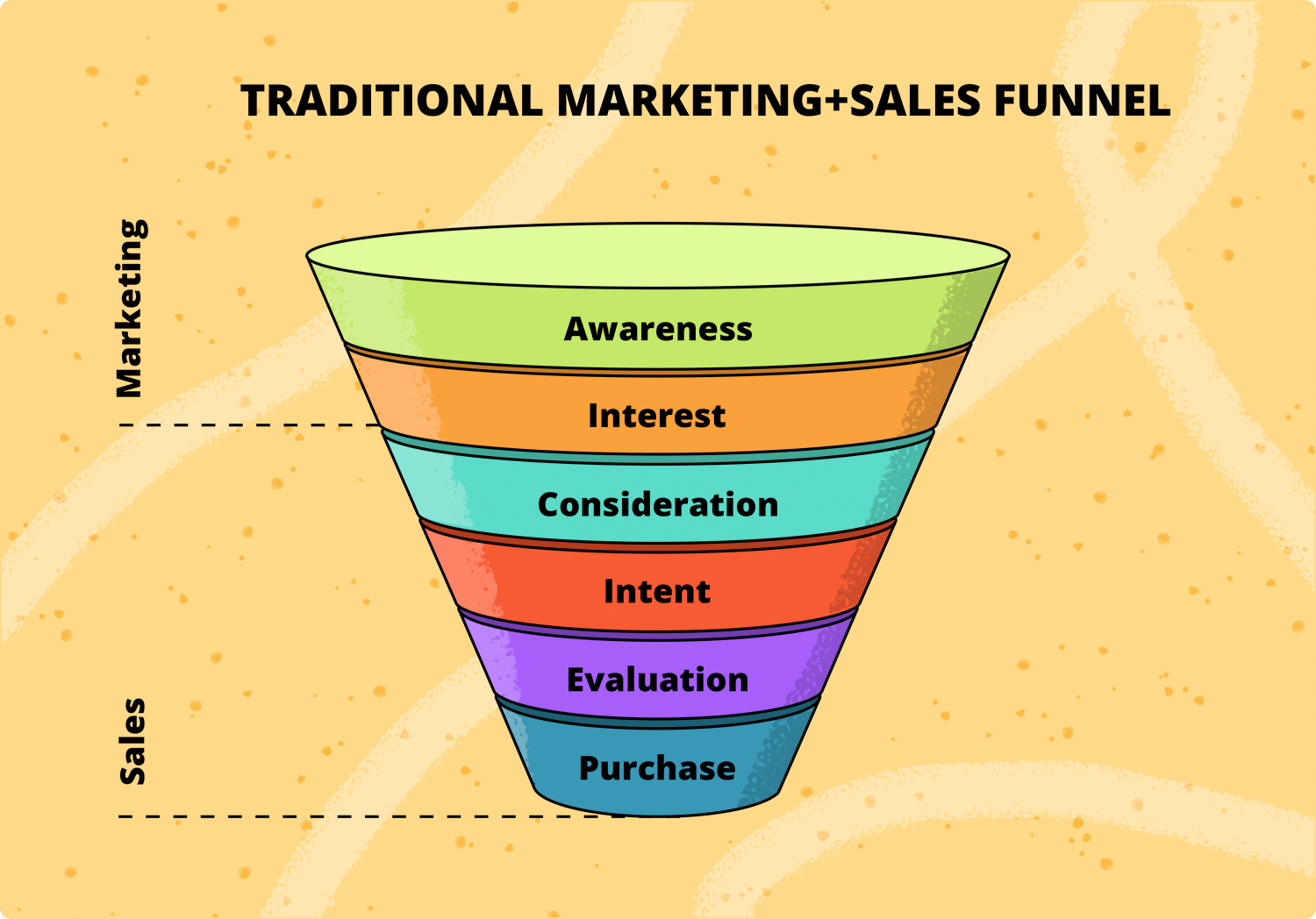
But buyer’s habits have changed:
- Now, 80% of B2B purchase cycles are complete before the buyer considers contacting your company.
- 68% of buyers prefer online research to communication with your sales team.
- And 90% of buyers won’t even answer your cold call!
Besides, your customers are constantly engaging with your brand — before they purchase and well after you close a deal. So, the ‘marketing first, sales next’ linear process seems no longer effective.
Smarketing is a new business reality
Smarketing functions like a family where both parents care about their child — a customer. Each parent contributes to another, while both build a common pattern of behavior.
Let’s translate it to the sales and marketing alignment.
A marketing team supports a sales team by:
- Making buyers aware of a company and its product
- Nurturing and qualifying leads
- Consistently engaging customers
- Providing data about the market and competitors.
A sales team, in their turn, contributes to marketing by sharing information about:
- Sales process efficiency
- Market dynamics
- Customer health (pain points and needs)
- Ideal customer profile
They intersect for:
- Building transparent goals and objectives
- Ensuring smooth handoff between marketing-generated leads and sales
- Maintaining positive customer experience
- Making cross-functional contributions to the go-to-market strategy.
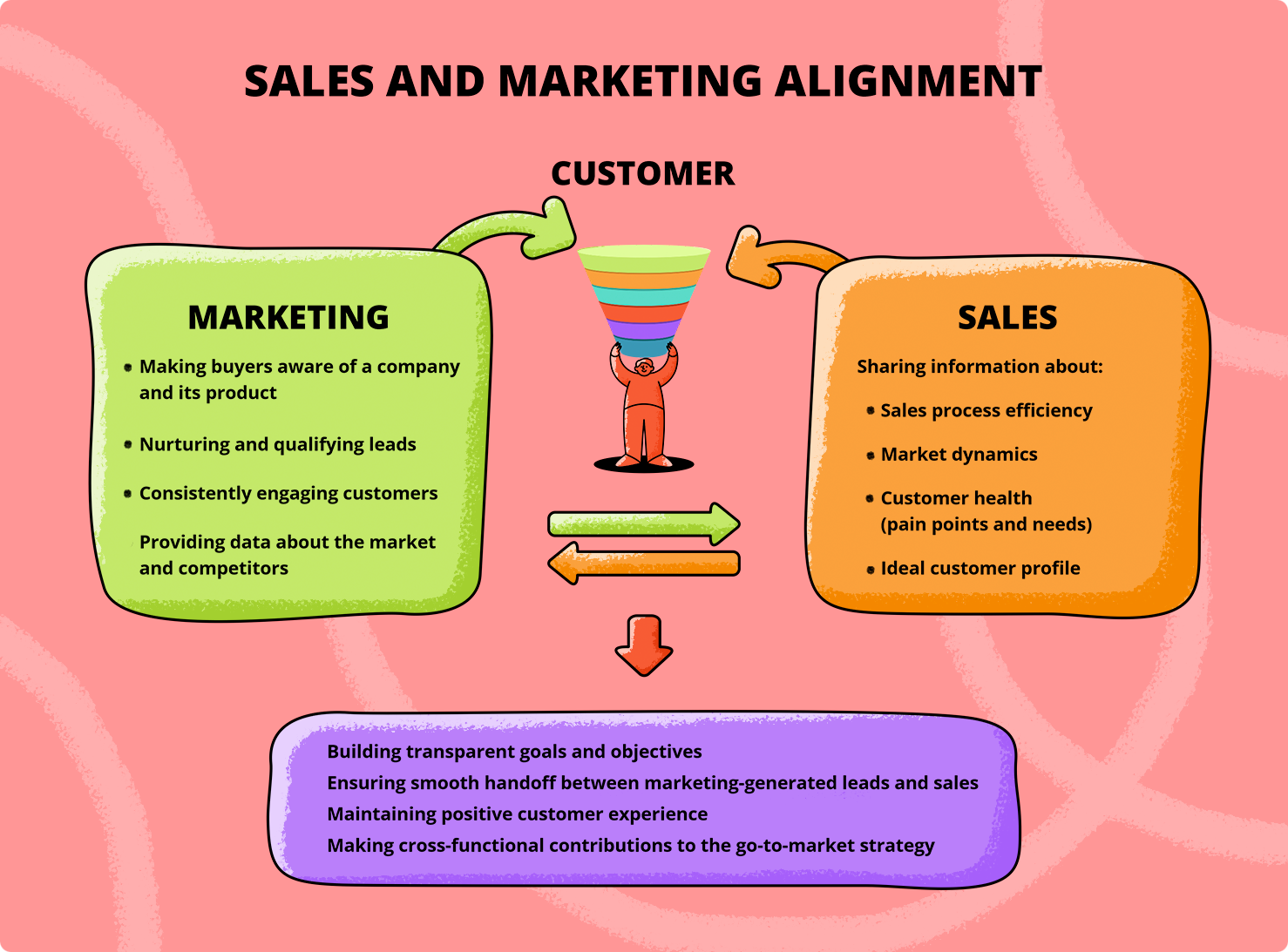
Why do you need Smarketing?
The primary justification for aligning your sales and marketing is that with Smarketing, you are able to face the challenges a complex buying cycle imposes on both teams.
Let’s find out what they are and how Smarketing may solve them.
Problem 1: Lead generation and handoff
One of the widespread stories: a marketing team has generated hundreds of leads, but a sales team complained that they are not qualified enough. Lead generation is one of the most burning challenges businesses face, and that’s where numbers speak louder than words:
- About 79% of marketing leads never convert into sales due to poor lead nurturing.
- Only 56% of B2B organizations properly validate leads before they are passed to sales.
- 61% of B2B marketers send all leads directly to sales, but a sales team touches only 27% of them.
How Smarketing helps solve it: By aligning sales and marketing, you’ll be able to agree on an ideal customer profile and lead qualification algorithms. This way, both teams will have a clear vision of who their leads are and how fast they should be acted on to engage interested customers and take all sales opportunities.
As a result, you’ll improve lead generation and lead nurturing mechanisms.
Problem 2: Sales content utilization
Similar to lead enrichment, sales may not hurry up to approve the content created and developed by marketers. In fact, 60-70% of B2B content created is never used. In a scenario when sales make little or no input in content themselves, it fails to meet their needs and has no influence on deals.
How Smarketing helps solve it: By aligning your sales and marketing processes, your marketing team will get enough customer knowledge shared from sales and create content that will meet their needs, so they’ll adopt it for meeting their sales goals.
Problem 3: Demonstrating ROI
It isn’t easy to understand the actual value of your marketing and sales campaigns without measuring their performance. But how will you get to the real ROI of your business campaigns when sales and marketing are misaligned?
How Smarketing helps solve it: Aligning both teams, you’ll track and measure results in an integrated way and have a more transparent view of a company’s performance.
Problem 4: Streamlining workflows
When sales and marketing operate as entirely different organizations, there’s little opportunity to move the process forward from a stale point.
How Smarketing helps solve it: Alignment allows sharing tools, i.e., using the same platform for sales and marketing teams. As a result, team leaders access all customer data and metrics and analyze them in sync, speeding up your sales cycle.
Problem 5: Customer retention
One thing is to acquire new customers, and another is to encourage them to return.
How Smarketing helps solve it: By syncing sales and marketing, you’ll be able to get 36% higher customer retention rates. And by increasing these rates by at least 5%, you can grow your profits by 25% up to 95%!
The game is worth the candle!
By Aligning your sales and marketing processes and solving all the problems mentioned above, you’ll be able to:
- Achieve 24% faster three-year revenue growth and 27% faster three-year profit growth.
- Become up to 67% better at closing deals and enjoy 38% higher sales win rates.
- Enjoy up to 208% growth in marketing revenue.
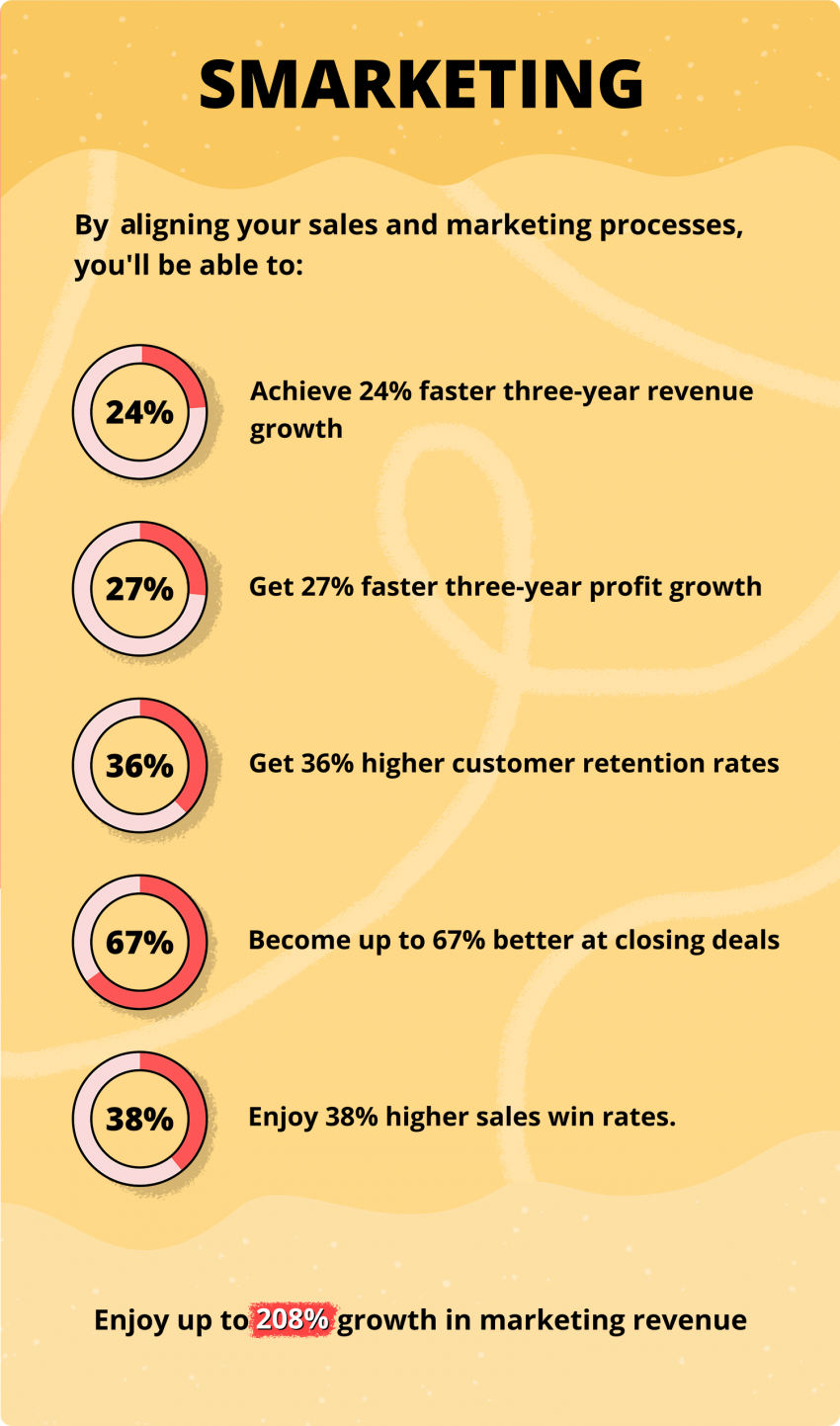
Sounds impressive, doesn’t it?
How to align sales and marketing to increase revenue: 10 best Smarketing strategies
Smarketing may work miracles, but aligning both teams isn’t an easy part. It involves a step-by-step process, takes time and much effort.
But we’ve got you covered! Here are 10 strategies that will help you get on the right track immediately and enjoy revenue growth in the long run.
1. Define common terms
The first step to achieving sales and marketing alignment is to agree on the standard terms. It seems logical, but in reality, only 44% of companies have decided on the definition of a qualified lead between their sales and marketing teams.
And when it comes to lead scoring, for example, sales and marketing should come together to define the scorecard to have the same understanding of the lead’s position in the sales cycle and their fit to the business overall.
2. Set mutually agreed goals
Historically, marketing specialists are prone to more generalizing goals, say, the number of leads generated. At the same time, sales have a more individualistic view, e.g., closing a specific account. To align your sales and marketing, both teams should realize they are working towards achieving the same goals.
This includes agreeing on the processes that should be put in place at each sales funnel stage and focusing on the key metrics they can measure and influence, such as conversion rate or lead value.
3. Make a single customer journey
From the awareness stage to the decision stage of the customer journey, everything should be tied together and perceived by both sales and marketing teams as a single experience. This will allow them to stay in sync while tracking all customer interactions through the entire funnel.
4. Agree on a buyer persona
You won’t go far if your sales and marketing teams have a dissociated view of who your ideal customer is. Marketers may have done a great job by researching customers, they may have done an even greater job by engaging them with your brand. But they probably haven’t spoken to prospects and don’t clearly understand their real needs and pain points. Well, sales do.
To ensure both teams have the same vision of a customer from head to toe, they should agree on the buyer persona.
For example, marketers can use research to develop the initial buyer persona image, which will be further refined as soon as sales gather their input. Alternatively, sales and marketing can share a buyer persona document that will be living, always up-to-date, and accessible by both teams.
5. Coordinate content marketing together
Content marketing is a very effective B2B marketing strategy for nurturing prospects when used by sales and marketing.
The teams should analyze what content works best at each stage of the buyer’s journey and find any missing assets. Besides, it’s vital to let salespeople contribute their ideas to content development. This way, sales will better understand how to use it effectively while marketers will get valuable insights into what content to create to boost sales.
6. Maintain a consistent marketing message
The biggest mistake you can ever make is to let marketers tell one thing about your product or service and allow sales to speak about it differently.
Mismatched messaging will give your customers nothing but a poor impression of your company. The latter, according to 21% of B2B marketers, is one of the most detrimental factors resulting from poor sales and marketing alignment.
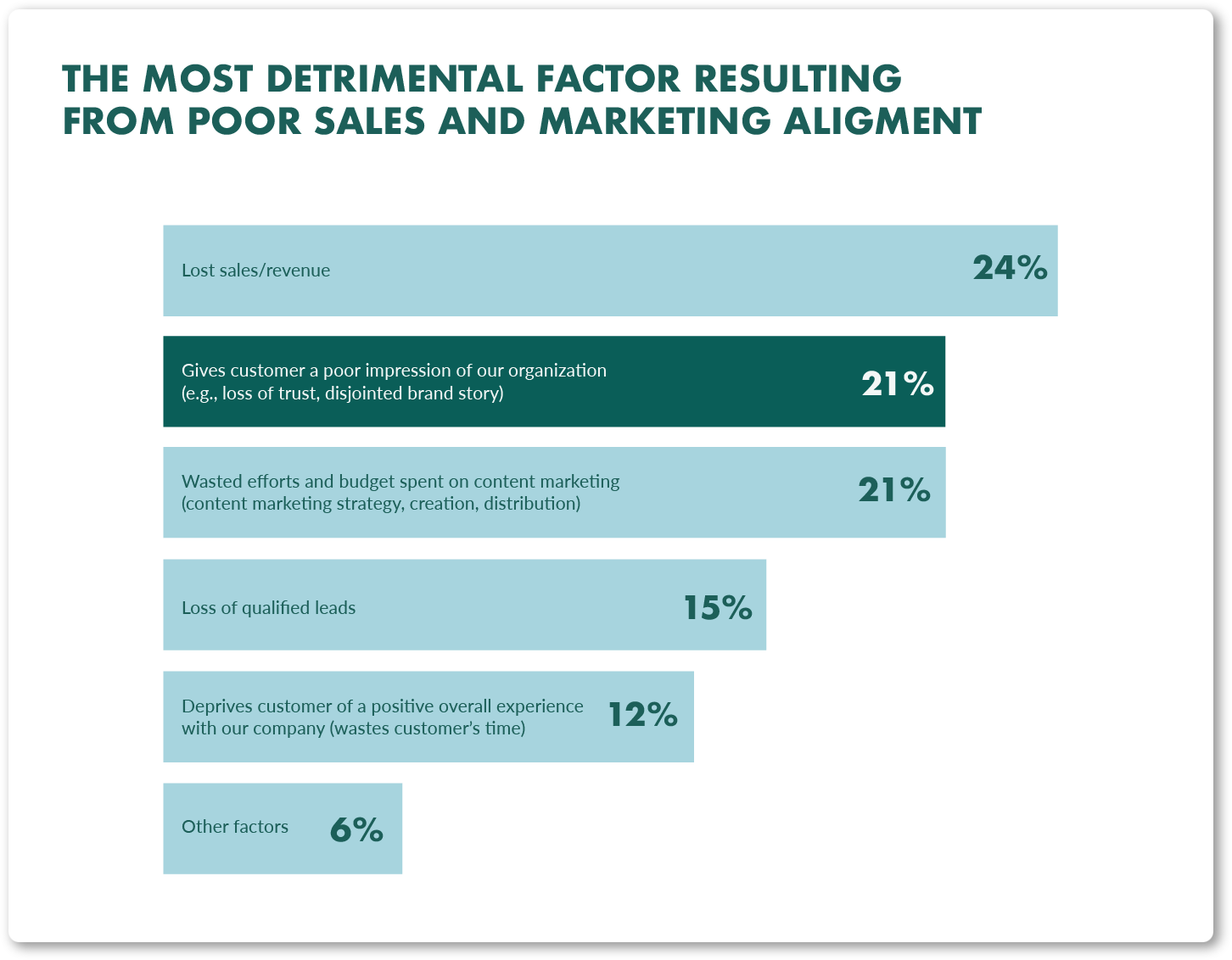
Ensure both teams have the same marketing message to communicate to your prospects. While marketers will be using it to warm up the audience, sales will reinforce its most resonating parts during their sales pitch — and close more deals.
A critical point to remember is that your marketing message must be customer-centric and reflect your value proposition. Both sales reps and marketers should realize they are, first of all, bringing value to the customer, not just making them read an email or purchase a product by all means.
7. Share reporting
Smarketing isn’t only about setting goals together. It’s also about tracking together how these goals have been achieved.
So, while aligning your sales and marketing processes, think about tracking joint KPIs and making the learnings of both teams transparent. This way, you’ll detect any weak areas in the customer acquisition funnel and direct mutual efforts towards improving the main metrics — revenue growth.
8. Join efforts in customer retention
By aligning sales and marketing, you’ll get way more leads and customers. But that’s not the destination point of a strong business player. Companies strive to retain existing customers as it’s 5 times cheaper than attracting new prospects.
Your sales and marketing teams should be in sync to increase the lifetime value of your customers. Ensure a company that has just purchased your solution isn’t left for granted. Marketers should inform your new customer of any updates, build loyalty programs, and do everything to encourage them to stay. Meanwhile, the sales team should always be ready to join the game.
9. Facilitate constant communication
To get connected, sales and marketing should stay connected. Regular cooperation is a sure way to avoid both teams being siloed.
This is how you can arrange constant communication between teams:
Hold onboarding Smarketing meetings
As soon as there’s a new salesperson in the team, get to know each other, explain how marketers will be supporting the sales team, and share best practices from the very start.
Let marketers attend sales meetings
Presence at sales meetings will allow marketers to know more about sales goals and quotas. Besides, that’s a wonderful opportunity to discuss content ideas together.
Arrange meetings for managers
Regular monthly meetings for sales and marketing managers are a must to keep both teams aligned. Leaders should meet to analyze metrics, discuss any bottlenecks, and set shared goals for the forthcoming month.
An essential part of such meetings is making an SLA (Service Level Agreement) that outlines each team’s responsibility.
Arrange casual meetings
Whether it’s a sales or marketing event or an occasion your company has organized to celebrate the joint wins, let your sales and marketing teams spend time together outside a traditional work environment to get a bit more sense of connection.
10. Integrate sales and marketing software
To get a holistic view of your customer, keep track of their every interaction, and measure KPIs, you need to ensure sales and marketing share the tools, i.e., use the same software, making their cooperation transparent and tight.
The most effective technology used by companies that practice Smarketing is CRM. Some companies also use email marketing technology, analytic tools, content management systems, and marketing automation.

Today you may come across hundreds of platforms that would help you automate your business processes and keep your sales and marketing alignment as strong as never before. Snov.io is just one of them. It offers a free CRM and a handful of tools for lead generation, email address verification, email automation, and email tracking — all in one set.
In addition, you can integrate Snov.io with such apps as Calendly to schedule regular meetings between your sales and marketing teams.
Sales and marketing alignment: inspiring use cases
Now that you are forearmed with a dozen tips on how to start aligning your sales and marketing teams, get a drop of inspiration from some companies that are already using Smarketing for their revenue growth.
SuperOffice increased revenue by 10% within the first year of implementing Smarketing
SuperOffice, a CRM software producing company, experienced hard times in 2016 when its sales and marketing teams were dissatisfied with each other. Sales reps complained about the quality of sales-ready leads coming in, while marketing was unhappy about the sales not following up leads properly.
Luckily, SuperOffice took the challenge and developed social selling practices. Since this step concerned both sales and marketing teams, they were both involved in creating a plan on how to be more active on social media.
Sales and marketing became more aligned in holding regular meetings, discussing campaigns, content, goals, in short, sharing responsibilities.
Result: Since the adoption of Smarketing, the company has got:
- An increase in business leads by 168%
- An increase in social media visits to their websites by 61%
- An increase in social media impressions from 1,000 to 50,000 (per month!)
And most importantly, SuperOffice has managed to grow its revenue by 10% only within the first year of aligning their sales and marketing processes.
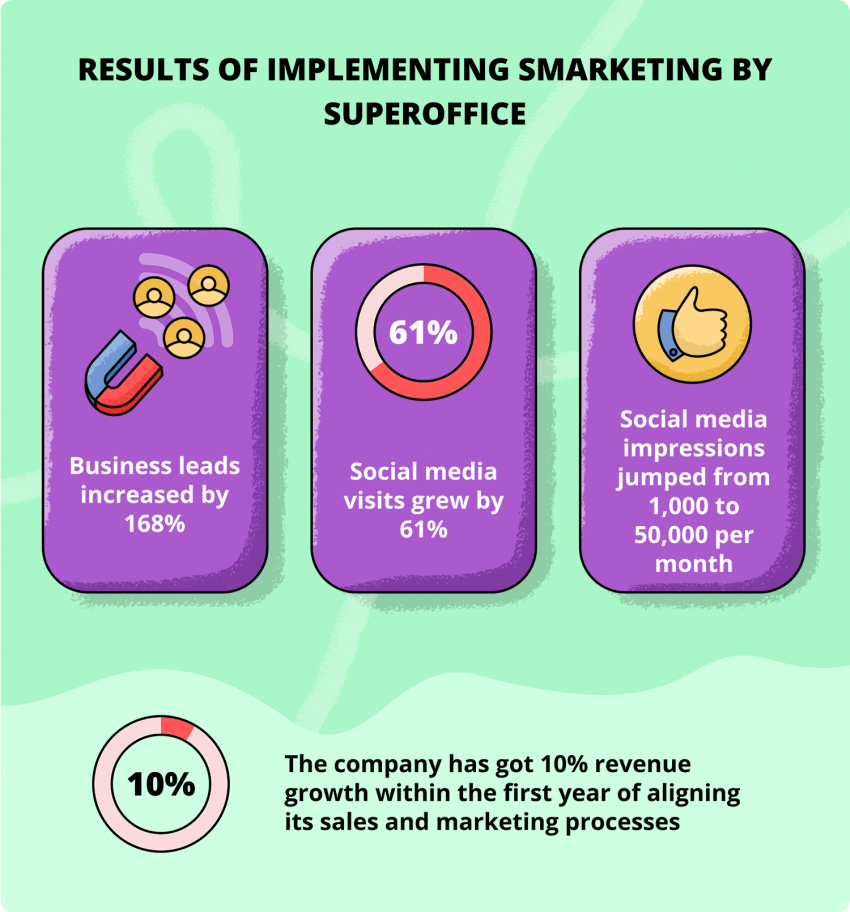
The story of pride and motivation…
Zoominfo boosted conversion rates from 4% to 15% with a clever sales and marketing alignment mechanism
Zoominfo, a software company providing B2B intelligence to businesses, has long ago arrived at the importance of aligning its sales and marketing processes.
The company had been facing difficulties with warm MQLs — prospects showing implicit interest through their behavior but not requesting more information. It tried to give responsibility for them to the sales dept, then to their special sales SWAT team, but nothing soothed the situation.
Then Zoominfo established an SLA that aligned sales and marketing, created a special sales role responsible for calling MQLs, and found an optimal number of dials per day (150).
Result: Conversion rate jumped from 4% to confident 15%.
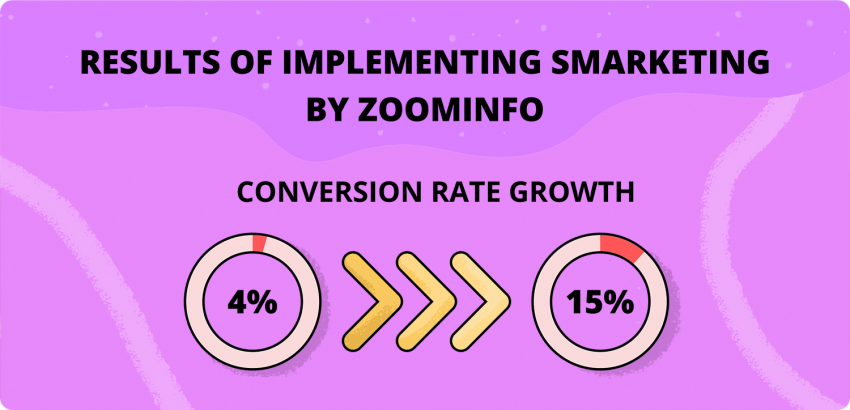
HLC aligning its sales and marketing through LinkedIn Sales Navigator
HCL Technologies, a global IT services company, had faced a common problem of misalignment between its sales and marketing teams when the question of lead qualification was concerned.
What helped the company unify its sales and marketing processes was the need to incorporate marketing automation, which led them to LinkedIn Sales Navigator, the tool that played the key role in HCL Smarketing adoption.
Both sales and marketing teams started using LinkedIn’s Social Selling Index (SSI) as their main KPI. Besides, each month the company began to publish a newsletter focused around Sales Navigator that displayed an internal leaderboard and included success stories. This allowed both teams to inspire each other and learn from their collective experiences.
Result: The company connected with more than 7K decision-makers and made $500 million worth of deals in contract value within two quarters.
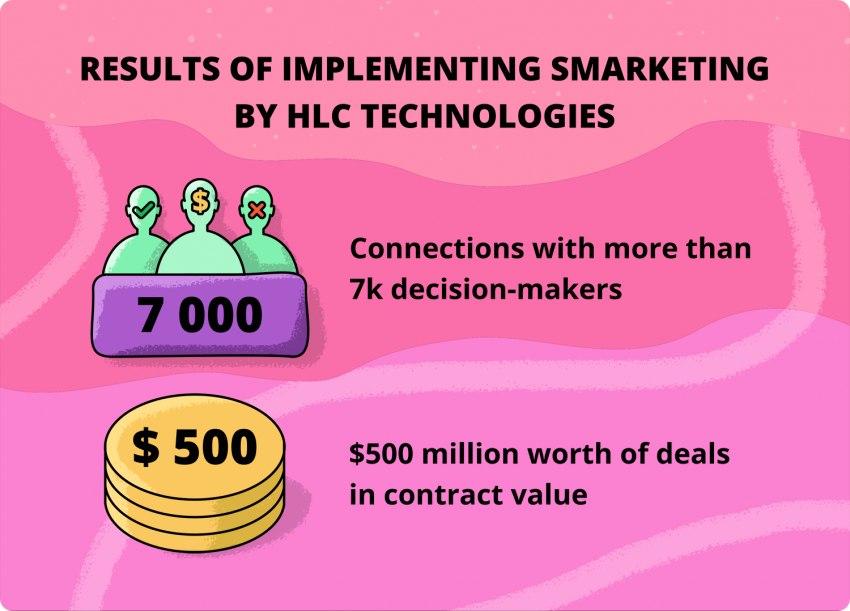
Wrapping up
Sales and marketing alignment, or Smarketing, is potentially one of the best opportunities for improving your business performance today.
Uniting both teams around a single revenue cycle, setting and tracking common goals, facilitating constant cooperation, and integrating software for automation and transparency, you’ll not only streamline your sales and marketing processes but create a strong body for business optimization and revenue growth.
Use Snov.io CRM as a reliable platform for your sales and marketing alignment, dive deeper in its versatile functionality, and enjoy moving your Smarketing forward.


